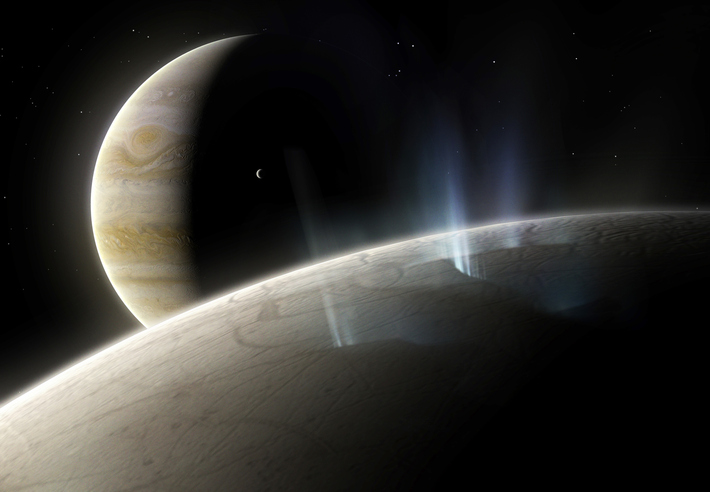NASA is set to launch a spacecraft to Jupiter’s moon Europa, considered one of our solar system’s most promising spots to search for life beyond Earth, to learn whether this ice-encased world believed to harbor a vast underground ocean is habitable.
The U.S. space agency’s robotic solar-powered Europa Clipper spacecraft will be launched on a SpaceX Falcon Heavy rocket from the Kennedy Space Center in Cape Canaveral, carrying nine scientific instruments. After traveling 1.8 billion miles (2.9 billion km) in a trip lasting about 5-1/2 years, Europa Clipper is due to enter orbit around Jupiter in 2030.
After a delay caused by Hurricane Milton, NASA set a tentative launch time for 12:06 p.m. ET (1606 GMT) on Monday.
Scientists have a keen interest in the salty liquid water ocean that previous observations have indicated resides below Europa’s icy shell.
“There is very strong evidence that the ingredients for life exist on Europa. But we have to go there to find out,” said planetary scientist Bonnie Buratti of NASA‘s Jet Propulsion Laboratory, the mission’s deputy project scientist.
“Just to emphasize: we’re not a life-detection mission. We’re just looking for the conditions for life,” Buratti added.
Europa Clipper is the biggest spacecraft NASA has ever built for a planetary mission, measuring about 100 feet (30.5 meters) long, about 58 feet (17.6 meters) wide and weighing approximately 13,000 pounds (6,000 kg). It is larger than a basketball court because of its sizable solar arrays to gather sunlight for powering scientific instruments, electronics and its other subsystems.
The spacecraft is due to fly by Mars, then back by Earth, using the gravity of each planet to increase its momentum like a slingshot. It has three main science objectives: gauging the thickness of Europa’s outer layer of ice and its interactions with the subsurface below, figuring out the moon’s composition, and determining its geology.
NASA is planning for its spacecraft to conduct 49 close flybys of Europa over a span of three years.
Europa’s diameter is about 1,940 miles (3,100 km) at its equator, roughly 90% that of our moon. Europa’s icy shell is currently believed to be 10-15 miles (15-25 km) thick, floating atop an ocean 40-100 miles (60-150 km) deep.
AN OCEAN WORLD
This moon is considered an “ocean world.” Even though Europa is just a quarter of Earth’s diameter, its subsurface ocean may contain twice the water in Earth’s oceans.
“As an ocean world, Europa is very intriguing. And this mission is going to help us to understand a complex piece of our solar system,” said Gina DiBraccio, acting director of NASA‘s planetary science division.
Ocean worlds, DiBraccio said, might be a common type of body outside our solar system.
“Clipper is going to be the first in-depth mission that will allow us to characterize habitability on what could be the most common type of inhabited world in our universe,” DiBraccio said.
Despite its hostile and frigid surface, scientists believe Europa could be capable of nurturing life. Buratti noted that there are three main requirements for life to form: liquid water, certain chemistry – specifically organic compounds that could serve as food for any primitive organisms – and an energy source.
Europa receives only about 4% of the solar radiation that Earth – five times closer to the sun – gets. But Buratti noted that Europa flexes as its orbit comes nearer and farther from Jupiter, thanks to the huge planet’s strong gravitational pull – a process that produces heat on the moon.
“That’s the source of energy we have,” Buratti said.
At the bottom of Europa’s ocean, where the water meets the rocky mantle, there may be thermal vents where heat releases chemical energy.
“They may be similar to thermal vents in the deep oceans of the Earth where primitive life exists and where life may have originated on the Earth,” Buratti said.
The spacecraft’s MASPEX instrument will sample gases to study Europa’s ocean, surface and atmospheric chemistries. MASPEX will look for “sophisticated organic molecules that could provide the food, if there are any primitive organisms,” Buratti added.
Jupiter is our solar system’s largest planet. Among its 95 officially recognized moons, Europa is fourth largest, behind Ganymede, Callisto and Io. Europa orbits about 417,000 miles (671,000 km) from Jupiter.
Buratti said exploratory missions like this one always uncover something “that we could not have imagined.”
“There is going to be something there – the unknown – that is going to be so wonderful that we can’t conceive of it right now,” Buratti said. “That’s the thing that excites me most.”
(Reuters)




















